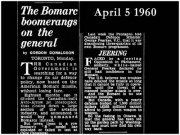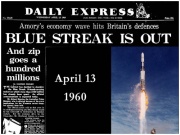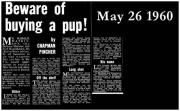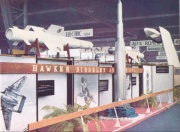The Empire Strikes Out - Canada's Defence & The Commonwealth Space Program - Part 6 by Robert Godwin
From The Space Library
Contents |
The BOMARC Cancellation
On February 16th 1960 Arnold Frutkin, Director of International Programs at NASA announced that his agency would like to purchase Skylark rockets from Britain, to be launched in Australia and tracked by mini-tracking stations in the UK and Canada. This positive gesture from NASA to cooperate on a new project with the main Commonwealth countries came in just a few days before the United States' Congress made a fateful decision.
Less than a year after selling Bomarc-B to Pearkes, the United States' government officially started to scale back its commitment to the missile. The standard Bomarc had been equipped with a liquid-fuel engine which on the Bomarc-B had been replaced with an untested solid fuel system. No less than seven Bomarc-B missiles had exploded on the launch pad in Florida.[1] Even without these problems the troubled system was essentially useless to Canada as it did not have the accuracy or range to strike an enemy aircraft. Instead it was intended to carry a nuclear warhead that would detonate somewhere in close proximity to any invading Soviet intruder. The critical downside to this strategy was that in the locations where it was deployed it would be dropping radioactive fallout near to populated parts of Canada. Prime Minister Diefenbaker and his cabinet could not decide whether to arm the missiles, in part because of this and in part because they didn't want Canada to seem to be contributing to the proliferation of nuclear weapons.
Diefenbaker insisted that NORAD should operate under the confines and regulations of NATO. He thought this would be the easiest way to maintain a level of control for the Canadian government which would otherwise be reduced to "satellite" status, in permanent thrall to Washington.
In April 1958 Diefenbaker claimed that the Defence Research Board had told him that the Bomarc had a longer range and a "kill potential in terms of cost that was likely to be ten times greater than that of the CF-105." He then later stated in his memoir that the Bomarc was ineffective against ICBMs but that he was given "no information that the United States would abandon, or had abandoned, its plans to manufacture a conventional warhead for this missile...It behooved us not to panic on the first evidence that we had acted on poor technological advice." Seven weeks before the cancellation of the Arrow even Blair Fraser of MacLeans magazine had warned of the implications of the U.S. cancelling BOMARC, citing Sparrow as an example of the severe potential repercussions to Canada's defence and economy.[2] The previous October Fraser had written a pointed editorial in which he emphatically applauded Diefenbaker for cancelling the Arrow, despite the fact that no such announcement had been made. Some senior Avro managers had handed in their notice as a direct result of the article only to be talked into returning by Minister O'Hurley who assured them that the aircraft would go into production.
When the news came into the Canadian parliament in the last week of March 1960 that the U.S. Congress was officially abandoning Bomarc General Pearkes was faced with jeers from the benches.
The Blue Streak Cancellation
Less than two weeks later his British counterpart faced the same reaction in Westminster when he announced the cancellation of Britain’s ground-based IRBM program. Blue Streak was also dead.
The statement made by British Defence Minister Harold Watkinson in the British Parliament had gone as follows:
"Vulnerability of missiles launched from static sites and the practicability of launching missiles of considerable range from mobile platforms has now been established. In the light of our military advice and the importance of reinforcing the effectiveness of the nuclear deterrent, the Government has concluded that it ought not to continue to develop as a military weapon a missile that could be launched only from a fixed site."[3]
Of course this implied that if Britain's fixed base missiles were vulnerable, then so were Canada's. Ironically this announcement in England came the very same day that the Bomarc-B finally had its first successful firing.
Two Commonwealth countries’ missile defence programs were threatened within days of each other, ostensibly for the same reason. Both countries were suffering from similar self-inflicted wounds. Pouring vast sums of money into large projects and then cancelling them without having a tested viable alternative.
Canada's alternative was already being melted down in Hamilton Ontario, while Britain's only option was to start all over again with something new, or, like Canada, turn to their allies in the United States. Blue Streak still had a potential second life beyond its role as a weapon. Almost immediately the defenders of the British missile began talks with France about using it as a space launcher.[4] This plan had been suggested directly to the Prime Minister by an industrial committee even before he had announced the cancellation of Blue Streak.[5]
In the British House of Commons a highly respected Conservative MP and aviation expert named Frederick Farey-Jones stood up and berated his own party,
"Will Mr. Watkinson bear in mind that this is not just a question of expenditure?
"It is a question of Commonwealth participation in scientific progress over the next 100 years, compared with which a figure of £65,000,000 is a bagatelle.
"Will you bear in mind that the result is to put in pawn to the U.S. British scientific progress in the exploration of outer space for the next 25 or 50 years? And that this affects not only these islands but the Commonwealth?" [6]
Avro Blue Steel or Douglas Skybolt?
At this time Watkinson was just the latest in a long line of politicians (which included Pearkes) to be persuaded that there was a “missile gap” with the Soviet Union. The fear for Watkinson was that a massive ICBM strike on England, with only a dozen minutes warning, would effectively render Blue Streak useless. Sitting in its silos, and requiring considerable time to fuel, the Blue Streak was now considered a sitting duck. Watkinson spoke to his counterparts in Washington who reaffirmed that he needed to keep Britain’s H-bombs mobile and that the best way to do that was to put the British warheads into the brand-new, untested, air-launched Douglas Skybolt missile.
Skybolt was to replace a British wing-launched missile built by Avro named Blue Steel. Both could carry a one megaton warhead, but Blue Steel used high-test peroxide rocket engines built by Armstrong-Siddeley which were tricky to fuel on a runway and could take some time to prepare. The engines for Blue Steel were directly descended from the work that had taken place at Westcott after the war. Conversely Skybolt was to be a solid-fuel wing launched missile and in theory could be prepared much more quickly than Blue Steel. The engineers at Avro were convinced that they could make big improvements to Blue Steel but were never given the chance to convert it to a ramjet propulsion system. They were told to deploy the Mark 1 version as quickly as possible since Blue Streak was now cancelled.
However, before Watkinson would commit to Skybolt he first headed to Ottawa on May 27th 1960 to meet George Pearkes. A week earlier Diefenbaker had started to make comments in Ottawa that suggested he might now also cancel the Bomarc-B program. He used the example of Blue Streak in England as proof that he was not alone in making tough choices.[7]
Watkinson and the rest of the MacMillan government were now under siege because the decision to cancel Blue Streak had effectively threatened any hope of a domestic nuclear deterrent for Britain. As Watkinson departed for Canada the newspapers in England were drawing comparisons between Watkinson’s and Pearkes’ situations. One article even suggested that if Skybolt was cancelled in two years Britain would find itself in the same situation as Canada, defended by nothing but obsolete aircraft.[8] Watkinson’s dismissive response was “If the Americans cancelled it we wouldn’t want it anyway.”
Despite warnings from both sides of the Atlantic Watkinson went ahead and committed Britain to another completely untested Douglas missile system. Within a few days stories began to appear that the Skybolt wouldn't even fit in half of Britain's bomber fleet. The entire logic behind abolishing Blue Streak in favour of Skybolt was to have an airborne nuclear deterrent that had stand-off capability (i.e. the weapons would be flown by bombers to within a predetermined range of their target and then launched while the bomber flew home.) They could also become rapidly airborne making them much harder to target. The stand-off capability advocated in Britain for the Vulcan/Skybolt combination was exactly what Canada had just given up in the Avro Arrow; although it was not designed as a bomber it could have launched nuclear missiles from long range while simultaneously being a competitive fighter. James Floyd was certain that Britain would have purchased the Arrow.[9]
Woomera
Watkinson was also faced with another major problem—Australia. The launch site for Blue Streak at Woomera had cost the Australians a fortune. Its cancellation would be a catastrophe for the Australian government. Watkinson managed to allay their fears temporarily by persuading the Australians that Blue Streak would be used as a space launch system and on July 5th 1960 the British and Australians signed a joint space agreement. By September the British government stepped up their efforts to save face at home by publicly announcing their plans to make De Havilland's Blue Streak/Black Knight combination into a Commonwealth space launcher. To do this effectively they still needed more partners to help with the cost. The only option being considered was to approach the other Commonwealth members (i.e. Canada, Singapore etc) and the large European countries.
Despite the CAS having begun this dialog with British scientists two years earlier, any chance that Watkinson might have recruited Canada to a Commonwealth space program was now entirely out of the question due to the political fallout from the Arrow/Bomarc debacle. In fact the fallout from Bomarc was intensifying.
Go to Chapter
Footnotes
- ^ Daily Express Apr 5 1960
- ^ MacLeans Magazine Jan 3 1959
- ^ Globe and Mail Apr 15 1960
- ^ Daily Mirror Apr 20 1960
- ^ Space Technology in Western Europe – Kenneth Gatland 1963
- ^ Daily Express Apr 14 1960
- ^ Ibid May 20 1960
- ^ Daily Express May 26 1960
- ^ Cold War Tech War – Randall Whitcomb – Apogee Books 2008




